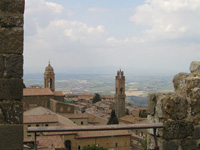| |
|
| |
|
|
|
|
|
|
| |
 |
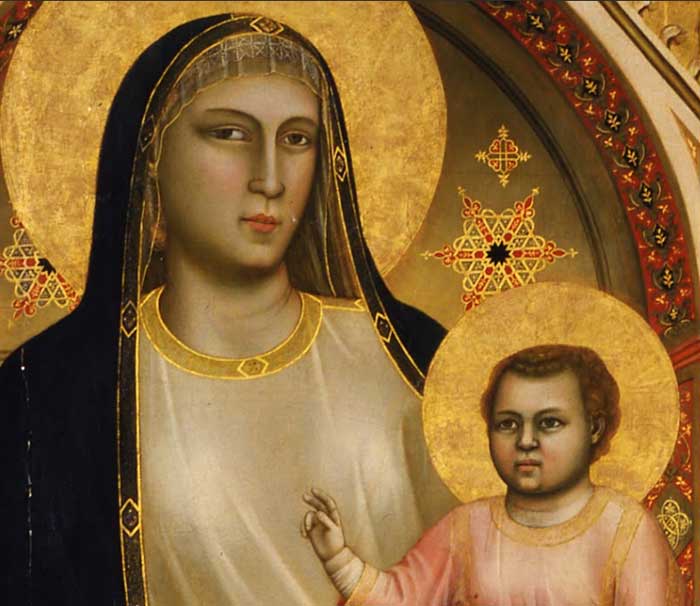 |
| Giotto di Bondone, Ognissanti Madonna (Madonna in Maestà), c. 1310, tempera on wood, 325 x 204 cm, Galleria degli Uffizi, Florence
|
|
 |
|
| |
|
|
|
| |
|
"Credette Cimabue nella pittura / Tener lo campo, ed ora ha Giotto il grido/ sì, che la fama di colui oscura "
Dante, Divine Comedy |
Giotto di Bondone | Ognissanti Madonna (Madonna in Maestà)
|
|
|
|
| |
|
In Florence, where documents from 1314–1327 attest to his financial activities, Giotto painted an altarpiece known as the Ognissanti Madonna and now in the Uffizi where it is exhibited beside Cimabue's Santa Trinita Madonna and Duccio's Rucellai Madonna. [1]
The Ognissanti altarpiece is the only panel painting by Giotto that has been universally accepted by scholars, and this despite the fact that it is undocumented. It was painted for the church of the Ognissanti in Florence, which was built by an obscure religious order known as the Humiliati. It is a large painting (325 x 204 cm), and scholars are divided on whether it was made for the main altar of the church, where it would have been viewed primarily by the brothers of the order or for the choir screen, where it would have been more easily seen by a lay audience.
The attribution of the large painting of the Madonna from the Florentine church of the Ognissanti (All Saints), now housed in the Uffizi Gallery, derives from a written notice from the early 15th century. The panel, described as the Ognissanti Madonna after the church in which it was originally installed, has the same strength of representation as the frescoes at Padua, and is therefore dated by art historians as having being painted in the first decade of the l4th century.
From the moment we look at the wooden panel painted in tempera we are fascinated by the gleaming solemnity of the paintwork. A fine web of golden edgings on the robes, of halos, and of decorative elements blends the golden hue of the background with the representation as a whole. Both the delicate shades of violet and pink, the warm green and red, and the flesh colours of the figures thus take on a brilliant luster, which allows the panel to shine with incomparable splendour.
Giotto turns to a type of picture known as the Maestà - the Madonna surrounded by saints and angels - which is especially well-known because of the Maestà by Duccio, begun in 1308, the one-time altarpiece of the cathedral at Siena, and through the great fresco in the Sienese Town Hall, completed by Simone Martini in 1315. These two examples of mature Sienese art have a relatively wide format: the numerous saints kneel and stand in rows to the left and right of the Virgin's throne. There they could be said to lead a "life of their own" — some look into the centre of the picture, others look at one another, and yet others direct their gaze out of the picture. Giotto's panel, on the other hand, is vertical in format and thus approaches the size and proportions of an older type of portrayal of the Madonna. This aspect is made particularly clear in the Uffizi Gallery in Florence, where the Ognissanti Madonna is exhibited next to Duccio's Rucellai Madonna and the Madonna S. Trinità by Cimabue, both of which were executed in the 1280s.
This representation of the Maesta, with its novel conception of the subject and its delicate style of painting, worked through with gold, numbers among the high points in Giotto's panel painting. Here, the natural portrayal and the solemnity of the mother and child are intensified in a special way. The clear perspectival composition, in which the clearly directed gaze of the surrounding figures is included, makes the Child's gesture of benediction appear as the focal point, both optically and as regards content.
|
|
|
|
| |
|
The famous painting of Maesta by Giotto, which dominates the first room of the Uffizi, was painted for the high altar of the Ognissanti in, or around, 1310. While historians have had trouble finding specific information for indisputably attributing many of Giotto's works to the artist, Madonna Enthroned is one piece for which there are a few documents supporting its creation by Giotto. There are many sources that show Giotto spent many years living and creating in Florence. However, the main source that documents Madonna Enthroned specifically is artist Lorenzo Ghiberti's autobiography, I Commentarii (1447). An earlier manuscript document of 1418 also attributes the painting to Giotto, but it is Ghiberti's autobiography that provides the most solid evidence.
One of Giotto's later works, Madonna Enthroned was completed in Florence, upon the artist's return to the city. It was originally painted for the Ognissanti Franciscan church in Florence. Built for the Humiliati, a small religious order at the time, the church had many acclaimed paintings designed for it. Specifically, Giotto's Madonna Enthroned was designed for the high altar.
The subject matter of this painting is a traditional, religious one, with the Virgin Mary, or Madonna, holding the Christ Child on her lap. Saints and angels surround the Madonna on all sides. This particular representation of the Virgin is called a Maestà, a popular representation at the time.
Influences
The Madonna Enthroned show the numerous styles of art that influenced Giotto. In both the gold coloring used throughout the artwork and the flattened gold background, Giotto's art continued the traditional Italo-Byzantine style so popular in the proto-Renaissance time period. The altarpiece represents a formalized representation of an icon, still retaining the stiffness of Byzantine art, and Giotto retained the hierarchy of scale, making the centralized Madonna and the Christ Child much larger in size than the surrounding saints and religious figures. |
|
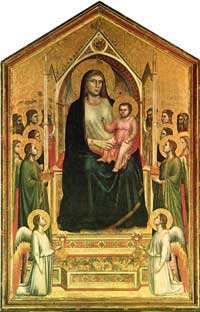 Ognissanti Madonna, Galleria degli Uffizi, Florence Ognissanti Madonna, Galleria degli Uffizi, Florence
|
Giotto's figures however escape the bounds of Byzantine art. His figures are weighty and are reminiscent of three-dimensional sculptures, such as that in classical Roman sculpture. The Madonna's intricately decorated throne, which itself is an Italian Gothic design, has a very specific use of colored marble as a surface decoration. This use of marble was a style that ended in the early Christian time period, and thus gives a clue that Giotto was knowledgeable of art of that time period.
There were, additionally, a number of specific artists whose styles heavily influenced The Ognissanti Madonna. The influence of Cimabue, traditionally recognized as Giotto's teacher, is shown first in the very symmetrical composition of the piece. Cimabue portrayed the same subject in his 1280 Virgin and Child Enthroned, and both pieces share aspects of the Italo-Byzantine style, with Cimabue's having more Byzantine attributes. Additionally, the two depictions of the angels' wings in Giotto and Cimabue's pieces clearly resemble each other. Both pieces share a similar, initial feeling of severity, yet there is more to each piece than the drama. Giotto adopted from his teacher the importance of, and the concern for, volume and forms in space.
The tranquility of Giotto's figures resembled also the style of Pietro Cavallini. From this artist, who painted neo-Byzantine pieces, taking cues from both mosaics and frescos from Roman and Early Christian times, Giotto took important lessons in the technique of painting, and in rendering figures as statuesque and calm.
Lastly, Giotto took cues from many contemporary sculptors, including Nicola and Giovanni Pisano, whose work shares influences of Northern Gothic art. In the work of these artists, Giotto saw great, dramatic compositions that would certainly influence his Ognissanti Madonna.
Technique
Giotto's painting was the first artist to depict three-dimensional figures in western European art. Additionally, he used a much smaller space than other contemporary artists, further emphasizing the importance of the bodies in the artwork. Giotto did away with many aspects of Byzantine art that would flatten the painting. Within Cimabue's Virgin and Child Enthroned, there is the use of gold tracing to delineate the folds of the fabric. In contrast to this, Giotto's fabric folds are more realistic, and instead of lines he used light, shadow, and color to create the appearance of fabric. Contours of the body underneath these fabric folds are also visible, specifically in the Virgin's knees and also around her breasts.
Giotto employs the technique of chiaroscuro, or the use of contrasts of light to achieve a sense of volume in his figures, giving them the slight smokiness that is usually characteristic of Leonardo da Vinci and later Renaissance artists. |
|
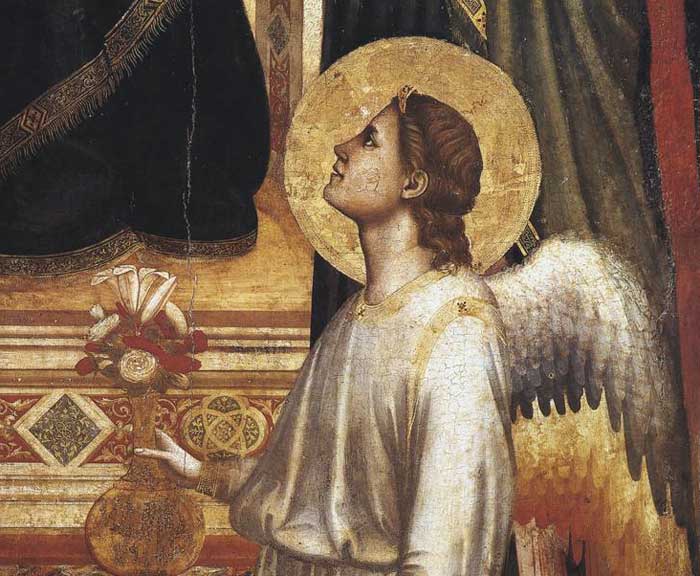 |
Giotto di Bondone, Ognissanti Madonna (detail), c. 1310, tempera on wood, 325 x 204 cm, Galleria degli Uffizi, Florence
|
| |
An angel kneels at either side of the step, left and right. We can recognize the space occupied by their strong, softly-modelled bodies very clearly by the way in which they either overlap or provide a glimpse of the steps behind. They do not hover like Cimabue's angels, and do not appear to have been simply applied to a flat surface like those of Duccio, but kneel with life- like gravity. In one hand the angels hold a vase containing a lily and red and white roses, the symbols of Mary's grief and of her purity. They look up at her. In order to overcome the distance, they bend their backs slightly and tilt their heads backwards. Doing so lends their gaze a certain directness and focus. And all the figures - the standing angels and the saints - are aligned with the centre in this way.
The intensity of these gazes reflects the perspective layout of the picture as a whole and concentrates adoration on the Virgin Mary and the Christ Child. It is exactly this feature which distinguishes the Ognissanti Madonna from all other Maestà representations by Giotto's younger and older contemporaries. The elevation of the central figures thus becomes almost completely natural, beyond all representative function and symbolic perspective, which Giotto - quite the child of his time - does not eschew, but does modify. |
|
|
|
|
| |
|
 |
|
|
[1] Giotto di Bondone was the leading artist at the start of Italy’s Renaissance and the Florentine School of painting. According to Giorgio Vasari (1511 – 1574), who dedicated a chapter to the painter in his The Lives of the Artists, Giotto was the tipping point of Italian art from the Byzantine style, into the Renaissance. It is said that that last great painter of the Byzantine era, Cimabue (1240 – 1302), discovered a young Giotto in his rawest form. As written by Vasari:
“One day Cimabue was going about his business between Florence and Vespignano, and he came upon Giotto who, while his sheep were grazing, was sketching one of them in a lifelike way with a slightly pointed rock upon a smooth and polished stone without having learned how to draw it from anyone other than Nature. This caused Cimabue to stop in amazement…”
It is from here that Cimabue brought Giotto into the bustling activity of the art world in Florence, where he excelled beyond measure of the time. How much of this story is true, is open for debate, but it is true that Giotto apprenticed in Cimabue’s studio in Florence. Vasari’s other account of Cimabue and Giotto tells of the young artist painting a fly so life-like that Cimabue continually tried to brush it off the canvas.
He also traveled with Cimabue to Rome and there may be several works that Giotto contributed to in Cimabue’s commissions. His earliest individual works include a fresco of the Annunciation and his quite large Crucifix, painted for the Santa Maria Novella in Florence. Giotto also painted in Rome from 1297 – 1300 and created his Badia Polyptych for the high altar of the Badia in Florence, which now hangs in the Uffizi Gallery.
Giotto’s masterpiece is often considered the fresco cycles he painted for the Scrovegni Chapel or Arena Chapel in Padua, with depictions of salvation seen in the Life of Christ and the Life of the Virgin and also a Last Judgment piece. The combined works, completed in the course of up to 7 years, have become known as a defining early masterwork of the Renaissance, going on to influence many artists in Florence and beyond.
Giotto painted other works in Padua, as well as in Assisi, and traveled back and forth between Rome and Florence. These made up most of his later works, including his Madonna altarpiece in the Church of Ognissanti in Florence, from around 1310. The piece, now in the Uffizi Gallery, finds its display in comparison to Cimabue’s Santa Trinita Madonna and Duccio’s (1255 – 1260) famous masterpiece, the Rucellai Madonna. Receiving a great number of religious commissions in Rome, Giotto also traveled to work in Bologna and Milan. The artist was also an accomplished architect, appointed to work on the Basilica di Santa Maria del Fiore, (The Duomo of Florence).
Dante (1265 – 1321) praised Giotto in the Divine Comedy, saying, “Once Cimabue thought to hold the field as painter; Giotto now is all the rage, dimming the luster of the other’s fame.” |
|
The Ognissanti Madonna is exhibited beside Cimabue's Santa Trinita Madonna and Duccio's Rucellai Madonna.
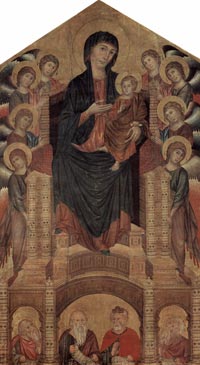 Cimabue, Maestà (Santa Trinita Madonna), 1280-1285, Uffizi Gallery, Florence Cimabue, Maestà (Santa Trinita Madonna), 1280-1285, Uffizi Gallery, Florence
|

Francesca Flores D'Arcais, Giotto, Abbeville Press, (October 1, 1995), New York, London, Paris.
|
|
This article incorporates material from the Wikipedia article Ognissanti Madonna published under the GNU Free Documentation License.
|
| |
|
|


Holiday accomodation in Tuscany | Podere Santa Pia | Artist and writer's residency
|
| |
|
|
|
|

. |
|
|
Podere Santa Pia |
|
Podere Santa Pia, garden view, April |
|
View from Podere Santa Pia
on the coast and Corsica |
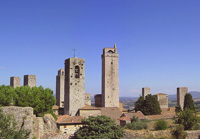 |
|
|
|
 |
| The towers of San Gimignano |
|
Montalcino |
|
Monte Argentario, view from Scansano |
| |
|
|
|
|
| |
|
|
|
|
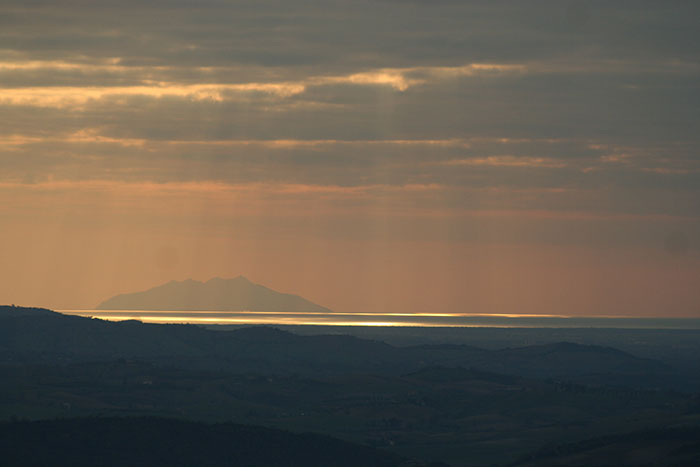 |
Montecristo. Situated in panoramic position, overlooking vineyards and olive trees, Santa Pia features incredible sunsets...
|
| |
|
|
The Church of Ognissanti or Chiesa di Ognissanti is a Franciscan church in Florence, founded by the lay order of the Umiliati. The church was dedicated to all the saints and martyrs, known and unknown.
It was completed during the 1250s, but almost completely rebuilt on Baroque designs of Bartolomeo Pettirossi, about 1627, with a facade - by Matteo Nigetti (1637) - that conserved the grand glazed terracotta lunette in the manner of the Della Robbia, now attributed to Benedetto Buglioni, over the doorway: Ognissanti was among the first examples of Baroque architecture to penetrate this Renaissance city. Its two orders of pilasters enclose niches and windows with fantastical cornices. To the left of the façade is a campanile of 13th and 14th century construction.
The Umiliati, by the dedication and probity of the lay brothers and sisters, gained a reputation in Florence, and dedicated works of art began to accumulate in their severely simple church. Giotto´s celebrated Madonna and Child with angels, now in the Uffizi, was painted for the high altar, about 1310. During the sixteenth century the Umiliati declined in energy, and the Franciscan order assumed control of the church in 1571, bringing precious relics such as the robe Saint Francis of Assisi wore.
In the interior, the Baroque remodelling, which provided a completely rebuilt apse with a pietre dure high altar and a sotto in su perpective (1770) on the vaulted nave ceiling, preserved quattrocento frescoes in the nave chapels, by Ghirlandaio and Botticelli, who is buried in the church.
A small round stone in a chapel of the right transept of the church marks the resting-place of a famous Renaissance painter. In the centre of the tombstone one can see the Filipepi family coat of arms, surrounded by the inscription in Latin containing the year of the artist's death - 1510.
Botticelli´s fresco of Saint Augustine in his Study, balances Ghirlandaio´s Saint Jerome in his Study in the chapel facing it across the navel, both executed in 1480. Perhaps the greatest of Ognissanti´s frescoes is Ghirlandaio´s Last Supper in the refectory between the two cloisters, a work with which Leonardo was intimately familiar.
In the Vespucci chapel, a fresco by Domenico Ghirlandaio with his brother David (about 1472), of the Madonna della Misericordia protecting members of the Vespucci family, is reputed to include the portrait of Amerigo Vespucci as a child.
Over the door to the sacristy is a crucifix in wood by Veit Stoss.
Art in Tuscany | Firenze | Chiesa di Ognissanti
|
|
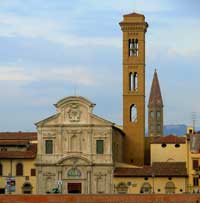
Chiesa di Ognissanti, Firenze |
 |
|
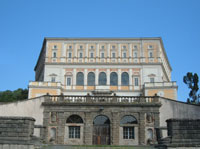 |
|
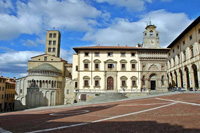 |
Sant'Antimo, between Santa Pia and Montalcino |
|
Farnese |
|
Arezzo |
| |
|
|
|
|
| |
|
|
|
| |
|
|
|
| |
|
|
|
| |
|
|
|
| |
|
|
|
| |
|
|
|





 Cimabue, Maestà (Santa Trinita Madonna), 1280-1285, Uffizi Gallery, Florence
Cimabue, Maestà (Santa Trinita Madonna), 1280-1285, Uffizi Gallery, Florence



